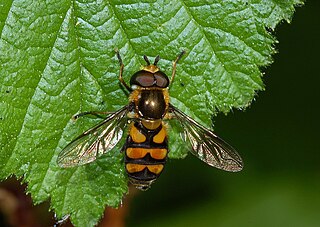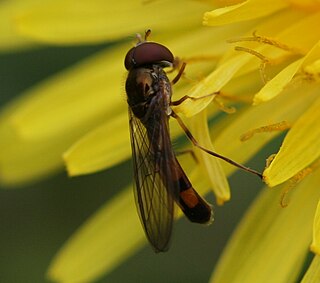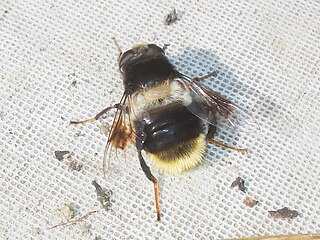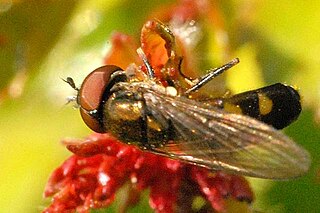
Hover flies, also called flower flies or syrphid flies, make up the insect family Syrphidae. As their common name suggests, they are often seen hovering or nectaring at flowers; the adults of many species feed mainly on nectar and pollen, while the larvae (maggots) eat a wide range of foods. In some species, the larvae are saprotrophs, eating decaying plant and animal matter in the soil or in ponds and streams. In other species, the larvae are insectivores and prey on aphids, thrips, and other plant-sucking insects.

Episyrphus balteatus, sometimes called the marmalade hoverfly, is a relatively small hoverfly (9–12 mm) of the Syrphidae family, widespread throughout the Palaearctic region, which covers Europe, North Asia, and North Africa. The upper side of the abdomen is patterned with orange and black bands. Two further identification characters are the presence of secondary black bands on the third and fourth dorsal plates and faint greyish longitudinal stripes on the thorax. Its color patterns may appear wasp-like to other animals, such as birds, protecting it from predation.

Eupeodes luniger is a common species of hoverfly.

Didea is a genus of hoverflies. Flight periods tend to be late in the year, and their larvae feed on aphids.

Melanostoma scalare, the chequered hoverfly, is a very common species of hoverfly.

Melanostoma mellinum is a very common species of hoverfly found in many parts of Britain, Europe including the Mediterranean basin and North Africa, the East Palearctic, and North America.

Baccha elongata is a species of hoverfly in the genus Baccha.

Eriozona is a genus of hoverflies in the subfamily Syrphinae.

Platycheirus splendidus is a species of hoverfly. It is found in many parts of Britain and Europe.

Platycheirus tarsalis is a species of hoverfly. It is found in many parts of Britain and Europe.

Ferdinandea is a genus of syrphid flies or hoverflies in the family Syrphidae. There are about 16 described species in Ferdinandea.

Lejops is a genus of hoverflies, closely related to the genera Helophilus, Quichuana and Mallota.

Parhelophilus is a genus of hoverflies. They are slightly smaller than flies of the genus Helophilus, and have a Holarctic distribution.
Chamaesyrphus is a genus hoverflies, from the family Syrphidae, in the order Diptera. Small yellow and black flies. Antennae with segment 3 large and almost evenly rounded, the arista only slightly thickened towards base and inserted before the actual anterior dorsal tip of the segment. In contrast to Pelecocera.

Brachypalpoides is a genus of hoverflies, from the family Syrphidae, in the order Diptera.

Arctophila is a subgenus of hoverflies, in the genus Sericomyia from the family Syrphidae, in the order Diptera, comprising several hairy, bee-mimicking species.

Pipizini is a tribe of small to medium-sized generally black hoverflies, although some species also have orange spots on their abdomen. This nondescript colouring can lead to some species being confused with other dark hoverflies from other tribes. The lack of a facial knob is a good defining feature which separates them from most of these other hoverflies. As with other species in the subfamily Syrphinae the larvae feed on aphids though there seems to be a preference for wax-secreting aphids e.g. Pemphigidae.

Chrysotoxum arcuatum, is a species of hoverfly. It is widespread throughout Britain and Ireland but much more common in the upland districts of the north and west where it is typically found at ground level near woodland and moorland edges. The larvae are thought to feed on root aphids associated with ant colonies.
Epistrophella euchromus is a European species of hoverfly.

Epistrophe melanostoma is a European species of hoverfly.


















